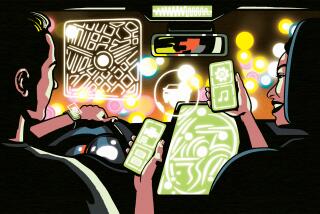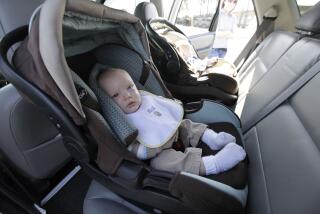Why Parents Need Extra Eyes and Ears
- Share via
As cars and trucks get bigger, their blind spots grow and it becomes harder to see what’s behind them. And as the world gets more complex and demanding, parents can become more harried and forgetful.
The result: a continuing national tragedy in which children are dying as a result of being left unattended in vehicles or being hit accidentally in their driveways.
Remember the Iowa mother whose 7-month-old daughter died in June after she had been left in a sweltering minivan all day? The woman, a high-ranking hospital executive, told police she had become preoccupied by her hectic schedule that morning and had forgotten the baby was still in the minivan when she drove to work.
A month later, in Stevenson Ranch in the Santa Clarita Valley, an 18-month-old girl was struck and killed in an accident that occurred in her driveway when her father was backing up his sport utility vehicle.
It shouldn’t happen, but leaving children alone in vehicles or allowing them to wander unsupervised around cars and trucks is something even the most conscientious parents do, said Janette E. Fennell, co-founder and executive director of Kids ‘N Cars, an advocacy group that tracks accidents involving children and cars. (The group is on the Web at www.kidsncars.org.)
The National Highway Traffic Safety Administration estimates that 116 children ages 1 to 4 die every year in backing-up accidents in residential driveways and parking lots.
As for deaths in cars, in California alone 27 children died in the five years before legislators last year voted to make it an offense in most cases, punishable by a $100 fine, to leave a child younger than 6 unattended in a vehicle.
Can such incidents be prevented?
Fennell argues that if the auto industry can install systems that warn us when our headlights are on, it should be required to equip vehicles with devices to protect children. She believes that available technology can thwart accidents.
Various aftermarket products, for example, are designed to alert drivers to the presence of people or objects behind them when they are backing up.
These include motion detectors that can alert drivers to small children who may be playing nearby but are hidden in the vehicles’ blind spots. Some emit beep tones or exhibit flashing lights; others use video screens to display images of what’s behind the vehicle.
A new product marketed by American Dealer Services Inc. uses a voice that warns drivers of potential obstacles--moving or stationary--behind their vehicles and tells how close they are. The company said its Micro 3 Bak-Talk uses echolocation sonar and can detect objects in a range of one to eight feet.
Other systems enable drivers to monitor babies in rear-facing car seats without having to turn around while driving. These systems also could serve to remind parents that there’s a baby in the vehicle.
One such product, Donnelly Corp.’s VideoMirror With BabyVue, uses a mini-camera mounted in the vehicle’s headliner and a small video screen integrated with the rearview mirror. The baby’s image is displayed on the video screen so parents can see if the child needs attention.
A tragedy similar to the Iowa case has led to the development of an alert system whose inventors are seeking a retailing partner to get it into the market.
The device was developed by researchers at NASA’s Langley Research Center in Hampton, Va., after an engineer at the facility left his infant son in the back of his Ford Explorer for nearly eight hours when he went to work. The 9-month-old died of overheating; authorities ruled the death an accident.
Some of the engineer’s colleagues decided to develop a system to alert parents who inadvertently leave children unattended in car seats.
“I wanted something that would serve as a second set of eyes and ears ... that could easily and inexpensively be retrofitted to existing child car seats,” said William Edwards, principal inventor of the Child Presence Sensor.
A weight-sensing device attached to the safety or booster seat is activated when a child is placed in the seat; an alarm, activated by the sensor, is attached to the driver’s key chain.
If the driver moves too far from the vehicle, the device sounds a series of warning beeps. If the driver fails to return to the car within one minute, the alarm beeps continuously and can be turned off only by the driver returning to the child safety seat.
Officials at the NASA center hope to license the technology to a commercial partner and make the device available to the public.
Regardless of what technologies are available, the ultimate responsibility rests with parents.
But for the sake of providing more protection for our children, federal safety agencies should consider requiring the auto industry to equip vehicles with devices that could help prevent such senseless deaths.
*
Jeanne Wright responds in this column to automotive questions of general interest. Write to Your Wheels, Business Section, Los Angeles Times, 202 W. 1st St., Los Angeles, CA 90012. E-mail: jeanrite@aol.com.






